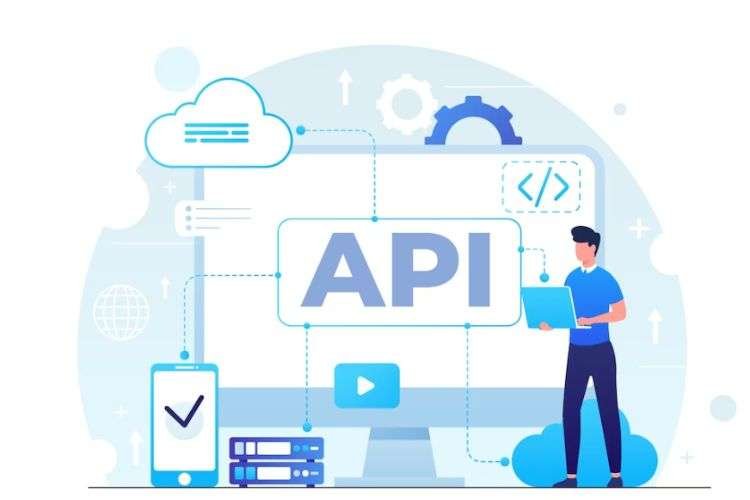
Close

BCoder Castle – Best Software App & Web Design Development Company 2023

An API (Application Programming Interface) is a set of protocols, routines, and tools that allow different software applications to communicate and exchange data with each other. It is an intermediary between different software systems, enabling them to interact and work together seamlessly. These rules may include data format specifications, authentication and access control protocols, and error and exception handling guidelines.
APIs work by receiving requests from a client application, processing those requests, and returning a response to the client application. The client application sends a request to the API, specifying the data it needs or the operation it wants to perform. The API processes the request and retrieves the necessary data or performs the requested function. It then formats the data as specified by the API protocol and sends it back to the client application as a response.
APIs can be used to access a wide range of services, such as social media platforms, payment gateways, and online marketplaces. They can also be used to integrate different software systems, such as connecting a website to a customer relationship management system or an inventory management system.
APIs (Application Programming Interfaces) can be broadly classified into four main categories based on their functionality and usage:
REST (Representational State Transfer) APIs are used to transfer data over HTTP/HTTPS using standard HTTP methods (GET, POST, PUT, DELETE) and a uniform resource identifier (URI). They are widely used in web-based applications and mobile apps to access and manipulate data. REST APIs are stateless, meaning each request is independent of any previous request, and the server does not store any session information.
SOAP (Simple Object Access Protocol) APIs are used to exchange structured data between applications over HTTP/HTTPS using the XML format. They provide a standard way of communicating between applications, allowing them to interact with each other even if they are written in different programming languages. SOAP APIs are more complex than REST APIs and often require more bandwidth and processing power.
GraphQL APIs are a newer type of API that provides a more efficient and flexible way of querying and manipulating data. Unlike REST APIs, which return pre-defined data structures, GraphQL APIs allow the client to specify exactly what data they need and receive only that data in response. This reduces network traffic and increases performance, making them a popular choice for mobile apps.
RPC (Remote Procedure Call) APIs are used to invoke functions or procedures on a remote server or service. They are often used in client-server architectures to allow clients to access server-side functionality without knowing the underlying implementation details. RPC APIs are typically faster and more efficient than REST APIs but require more programming effort to set up and maintain.

APIs, or Application Programming Interfaces, play a vital role in software development. APIs provide a standard way for different software components to communicate with each other and exchange data. Listed below are several benefits that software development can gain from utilizing APIs:
APIs allow developers to reuse code without having to rewrite it from scratch. This saves time and effort and makes software development more efficient.
Application Programming Interface makes it easier to scale software applications by allowing different components to be developed independently and then integrated using APIs.
APIs provide developers with pre-built functionality, which speeds up the development process and reduces time-to-market.
Application Programming Interface simplifies maintenance by providing a clear separation between the application’s interface and its internal workings.
It allow software developers to integrate their applications with third-party services such as payment gateways, social media platforms, and messaging services.
APIs enable the development of user-friendly and intuitive interfaces that can access complex functionality.
Social media platforms like Facebook, Twitter, and Instagram offer APIs that enable developers to access their data and integrate their functionality into other applications. For example, a developer might use the Twitter API to display a user’s tweets in their own application.
Payment processors like PayPal and Stripe offer APIs that enable developers to process payments securely and easily. For example, an e-commerce site might use the Stripe API to process credit card payments.
Mapping APIs like Google Maps and Mapbox provide developers with access to rich mapping and geolocation data. For example, a ride-hailing app might use the Google Maps API to display a map with real-time traffic data and directions.
News APIs like the New York Times API and the NewsAPI provide developers access to news articles and related metadata. For example, a mobile app might use the New York Times API to display the latest news stories in a particular category.

GraphQL: GraphQL is a query language that enables clients to request data from APIs in a more flexible and efficient way than REST APIs. As more developers become familiar with GraphQL, it is likely to become more widely used in the coming years.
Low-Code APIs: Low-code APIs allow non-technical users to create APIs without writing code. This trend is likely to grow as more organizations seek to democratize access to APIs and enable business users to create their own integrations.
API-First Development: API-first development is an approach that prioritizes building APIs before building applications. This approach enables organizations to create more flexible and scalable architectures and to iterate more quickly.
API Marketplaces: API marketplaces are platforms that enable developers to discover and consume APIs from a range of providers. As the number of APIs continues to grow, API marketplaces are likely to become more important in enabling developers to find the APIs they need quickly and easily.
There is a vast selection of APIs available for developers, each with its unique features and benefits for software and mobile app development solutions. At Bcoder Castle, we offer a full-stack solution for creating web and mobile applications, complete with API development capabilities. Our teams are highly skilled in developing innovative solutions that solve real-time problems and improve business productivity. With our expertise and technology, we can enhance the performance of your frameworks or integrate your IT infrastructure.

